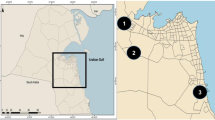Abstract
Some sites formerly used for waste disposal purposes, even if they are closed, continue generating leachate that seeps into the ground and contaminates groundwater in the area where they are located. It is believed that the rainfall being in contact with waste becomes a source of leachate. This fluid seeps into the aquifer and may identify sources of pollution. A modeling work which determined the migration times of solutes in the karstic aquifer of Merida, Yucatan, Mexico, is presented. Both existing and generated information was analyzed; a leachate plume was identified. The methodology used in the study is described, the application of which allowed concluding that this plume was generated from two sources: a waste disposal site and the oxidation lagoons located next to it. The procedure consisted of performing simulations considering the sources that contribute to the development of the pollution plume and forecasting their behavior. With the developed methodology, similar cases can be analyzed to avoid locating catchment zones of drinking water in inappropriate places and/or develop projects to place waste disposal sites that could affect existing catchment areas and to preserve this resource, essential for life.










Similar content being viewed by others
References
APHA, AWWA, WEF (American Public Health Association, Water American Works Association, Water Environment Federation) (1998) Standard methods for the examination of water and wasterwater, 20th edn. Greenberg A.E., Clesceri L.S. and Eaton A.D., USA
Brewerton LJ (1993) Aquifer Properties of Samples from Merida, Yucatan, Mexico. British Geological Survey. Technical Report WD/93/50
Casares SR (2002) Evaluación de riesgo a la salud por el consumo del agua subterránea subyacente al exbasurero de la ciudad de Mérida. Tesis de Licenciatura, Facultad de Ingeniería, Universidad Autónoma de Yucatán, México
Casares SR (2006) Hidrogeología de la zona de descarga del acuífero del estado de Yucatán y sus implicaciones ambientales. Tesis de Maestría, Facultad de Ingeniería, Universidad Autónoma de Yucatán, México
DGGTN (1984) Merida F16–10. Carta Geológica 1:250 000, 1st edn. Dirección General de Geografía del Territorio Nacional, Mexico
DGGTN (1985) Merida F16–10. Carta Hidrológica de Aguas Subterráneas 1:250 000, 1st edn. Dirección General de Geografía del Territorio Nacional, Mexico
Gonzalez RA (1996) Evaluación de la contaminación del agua subterránea en relación con el basurero municipal de Mérida, Yucatán. Reporte técnico (CONACYT 498100-5-1864-T9212), Facultad de Ingeniería, Universidad Autónoma de Yucatán, México
Gonzalez RA (2003) Monitoreo del exbasurero municipal de Mérida, Yucatán. Reporte interno, Facultad de Ingeniería, Universidad Autónoma de Yucatán, México
Gonzalez RA, Sanchez PI, Gamboa VJ (2002) Groundwater-flow modeling in the Yucatan karstic aquifer, Mexico. Hydrogeol J (IAH) 10:539–552
Gonzalez RA, Vadillo I, Rodriguez R, Carrasco F (2004) Sistema redox en un acuífero carbonatado afectado por lixiviado de basureros. Revista Latinoamericana de Hidrología 4:71–80
Graniel CE, Carrillo RJ, Cardona BA (2003) Dispersividad de solutos en el carst de Yucatán, México. Revista de la Facultad de Ingeniería 7(3):49–56
Harbaugh AW (2005) MODFLOW-2005, the U.S. Geological Survey modular ground-water flow model—the ground-water flow process. U.S. Geological Survey. Reston, Virginia. http://pubs.ugs.gov/tm/2006/tm6a12/pdf/TM6-A12.pdf
INEGI (2011) Perspectiva Estadística. Yucatán. Instituto Nacional de Estadística y Geografía. Diciembre 2011
Ku CLH (1998) Estimación de la producción del lixiviado generado en el basurero municipal de la ciudad de Mérida, Yucatán. Tesis de Maestría, Facultad de Ingeniería, Universidad Autónoma de Yucatán, México
Lesser JM, Weidie AE (1988) “Region 25. Yucatan Peninsula. In: Back W, Rosenshein JS, Seaber PR (ed) Hydrogeology. The geology of North America. Geological Society of America, vol 0–2, pp 237–241
Marín SL, Perry EC, Essaid HI, Steinich B (2004) Hydrogeological investigations and numerical simulation of groundwater flow in the karstic aquifer of northwestern Yucatan, Mexico. In: Coastal Aquifer Management. Monitoring, modeling and case studies. Lewis Publishers
Mendez RR (1993) Generalidades sobre la Propuesta de Reglamentación del Acuífero de Yucatán. Comisión Nacional del Agua. Gerencia Estatal de Yucatán. Subgerencia de Administración del Agua. Open File Report
Perez CY (2006) Factibilidad de determinar contaminación en el acuífero del exbasurero de Mérida por el método de resistividad eléctrica. Tesis de Maestría, Facultad de Ingeniería, Universidad Autónoma de Yucatán, México
Sanchez PIA (1992) Estudio del Comportamiento de la Contaminación del Agua Subterránea Generada por la Disposición Final de Desechos Sólidos a Cielo Abierto. Informe Final de Proyecto de Investigación. Unidad de Posgrado e Investigación. Facultad de Ingeniería. Universidad Autónoma de Yucatán. Reporte Interno. Mérida, Yuc., México
Sanchez PIA (1993) Estudio del comportamiento de la contaminación del agua subterránea generada por la disposición de desechos sólidos a cielo abierto. Reporte técnico (89-01-0801), Facultad de Ingeniería, Universidad Autónoma de Yucatán, México
Sanchez PIA (1999) Modelo numérico del flujo subterráneo de la porción acuífera N–NW del estado de Yucatán: implicaciones hidrogeológicas. Tesis de maestría. Universidad Autónoma de Chihuahua, México
Vazquez MPM (2007) Hidrogeoquímica de un acuífero cárstico afectado con el lixiviado de basureros. Tesis de Maestría, Facultad de Ingeniería, Universidad Autónoma de Yucatán, México
Villasuso M, Gonzalez R, Sanchez I, Frias J (1989) Alteración de la interfase salina por pruebas de inyección en Yucatán. Revista Agua Potable. Año IV 57:16–21
Zheng C (2006) MT3DMS: A modular three-dimensional multispecies transport model for simulation of advection, dispersion and chemical reaction of contaminants in groundwater systems. Department of Geological Sciences, University of Alabama, pp 46. http://hydro.geo.ua.edu/mt3d/
Acknowledgments
The authors express gratitude to: the Engineering School of the Autonomous University of Yucatan, Mexico, for the provided facilities, equipment and transportation to carry out field and laboratory work; the National Council of Science and Technology (CONACYT) for funding the research projects from which this work derives and the fellowship for Rodolfo Gomez to complete his graduate studies. This work was part of his master’s degree thesis in environmental engineering. The authors also thank the reviewers for their invaluable comments for improving this paper.
Author information
Authors and Affiliations
Corresponding author
Rights and permissions
About this article
Cite this article
Gonzalez-Herrera, R., Gomez-Lopez, R. Two in one leachate plume in a karstic aquifer. Environ Earth Sci 68, 1945–1953 (2013). https://doi.org/10.1007/s12665-012-1882-x
Received:
Accepted:
Published:
Issue Date:
DOI: https://doi.org/10.1007/s12665-012-1882-x




